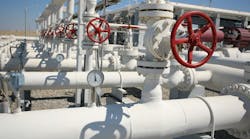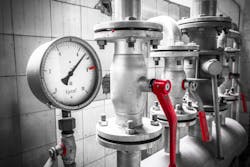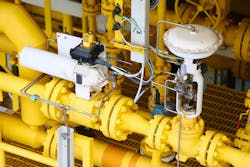Industrial valves are indispensable flow control devices that regulate, isolate, initiate, stop, and alter the direction of fluids. These devices can also relieve excess pressure from a piping system or from pressurized vessels. There are multiple valve designs and sizes to suit different industrial applications. Choosing or utilizing the wrong valve can affect the quality and consistency of industrial processes negatively. Engineers consider several process variables, fluid properties and environmental conditions when sizing and selecting valves.
Effective industrial valves should provide a reliable and durable fluid service — dispensing fluids at the required flow rates, sealing against leakages, backflows and emissions, and maintaining optimal sensitivity to pressure and temperature changes in the pipeline. Valve components should provide adequate physical and chemical resistance to corrosion by service fluids and immediate environments.
Understanding the operation of different categories of valves is beneficial for choosing and customizing flow control solutions for several industrial applications. How complex is the valve selection process, and what factors should engineers consider when selecting industrial valves to minimize their total cost of ownership?
1. Compatibility of Valve Materials with the Service Media
Industrial pipelines handle fluids with different physical characteristics — they can be liquid, gaseous or semi-solid (slurries), with varying chemical compositions. One should explicitly understand the qualities of the service fluid before choosing a valve. Materials used to manufacture valves should provide adequate resistance to the erosive actions of service fluids. Abrasive fluids cause premature failure of internal components like seals and closing mechanisms.
Ensure that valve materials are compatible with the service media. Extreme fluid service pipelines — like industrial chemical pipelines, viscous fluid service and cryogenic applications — require valves made from stainless steel, molybdenum and/or even chromium alloys. The valves can utilize metallic or chemically resistant seals. These materials provide excellent corrosion resistance and can accommodate extreme temperature and pressure changes. If unsure of compatibility, always talk with a valve engineering expert to confirm proper configuration for your service.
2. Temperature and Pressure Classifications
Every pipeline has a specific temperature and pressure class, defining the allowable operating range. The performance of an industrial valve should remain consistent as the pressure and temperature of the service fluid change. High process temperature and pressure can lower the strength of valve materials, increasing the risk of valve shell rupture.
When selecting industrial valves, one should confirm if the temperature and pressure range is within the desired pipeline ratings. Valve materials and wall thicknesses should accommodate the maximum pressure and temperature of the pipeline without failing over multiple cycles. The valve should provide a reliable safety margin, in case an emergency causes fluid conditions to exceed the designed limits. Manufacturers rely on standards like ASME B16.34, which defines the allowable pressure and temperature ratings for different body materials.
3. Applicable Valve and Industry Standards
Before selecting an industrial valve, one should consider the pipeline locations and the applicable standards within that jurisdiction. Several valve standards exist in the market. The most popular standards are EN for the European market and American Society of Mechanical Engineers (ASME) for the American valve market. Other associations, like the American Water Works Association (AWWA), have developed additional valve standards.
The choice of industrial valves should adhere to the standards used to design and configure existing pipeline systems. It may be impossible to install a valve bearing certain specifications in a particular location unless it has received additional approval and certification. For example, a high-pressure gate valve, manufactured with ASME standards, can only be used in Europe if it bears a CE marking. One should always double-check the relevant regional standards and additional approvals required when using a different standard to guarantee maximum valve safety.
4. Valve Leakage Ratings and Testing Standards
Valve trim design determines the allowable leakage rates valves can provide when conveying different fluids. Valves undergo rigorous testing after manufacturing, and are assigned leakage classes accordingly. Every leakage class has a maximum permissible leakage rating that determines where particular valves can be used. There are six leakage classifications as specified by the ASME.
The leakage classes determine the type of seating materials for different valves. A ball valve with a Class VI leakage rating has soft seats made from materials like Teflon or PTFE, while Class IV valves have metallic seats.
When choosing industrial valves, one should identify the acceptable leakage levels and type of service media. Ensure manufacturers adhere to the recommended testing standards when assigning leakage ratings to new valves.
5. Valve Actuation Requirements
Actuators automate valve operation in industrial pipelines to ensure consistent and accurate fluid control. The actuator delivers sufficient forces to stroke the valve closure mechanism and overcome frictional forces exerted by the service fluid, allowing process engineers to operate valves remotely. Valve actuation mechanisms include:
- hydraulic actuators
- pneumatic actuators
- electrical actuators.
Each actuation mechanism requires an external power source and exhibits unique performance characteristics. A pneumatic actuator provides a faster cycle time and is more durable than an electric actuator. A hydraulic actuator provides more torque — to actuate valves in large pipelines, requiring more force to operate.
When choosing an actuator, one must consider its size, availability of external power sources, and industrial setting environment to be able to distinguish the best option for durable and consistent actuator performance.
6. End Connection Types
Valves are designed to be installed between existing pipes. The valves have specific end connections that are compatible with the flanges of adjacent pipes. Valve connection points can be a source of leaks and emissions that can threaten the safety and reliability of piping systems. Common end connections can be:
- thread end type
- welded ends type
- flanged end type.
Threaded and flanged connections are easy to install and unmount when maintaining or replacing faulty valves. The flanges and threads adhere to different valve manufacturing standards for universal compatibility. Welded valve connections are critical for high-temperature and pressure applications with strict leakage and emission control requirements like chemical processing pipelines.
Process valves should have the right end connection types, compatible with existing piping systems for easy installation and maintenance.
7. Operate and Install Valves Properly
One can choose the correct valve for a fluid application but fail to achieve the required fluid control standards due to poor handling when installing and operating valves. Some valves are designed for installation in horizontal pipes, while others are used in vertical and horizontal pipe orientations. Poor handling and storage of valves before installation can damage the sealing elements or tamper with the end connections, causing difficulties during the installation.
Valves should be transported upright, with end caps and seals retained until they arrive at the installation point. Lift heavy valves using eyebolts. During installation, engineers should align the valve properly and use the correct torque (force) to connect it to adjacent pipes.
Once installed, valves should operate within the designed limits. Operators should follow correct procedures when opening or shutting manually-operated valves, and adhere to recommended factors of safety to prevent premature valve failures.
8. Valve Maintenance Requirements
Valve maintenance is essential for extending a valve’s durability and safety. A valve experiences internal wear and tear caused by the service media and external damage due to environmental impact. Failure to inspect and maintain valves increases their probability of failure, causing fugitive emissions, leakages, safety hazards, and irregular fluid control.
Some valve maintenance activities include:
- cleaning
- lubrication
- leakage inspections
- exercising (for less frequently cycled valves)
- replacement of trim components.
Companies should establish reliable measures and schedules for implementing corrective and preventive activities for industrial valves. Engineers should identify maintenance requirements for each valve and define the frequency for inspecting and rectifying faulty valves. The replacement parts should meet the original manufacturer's standards to ensure optimal valve performance.
9. Valve Safety Measures
Industrial equipment, including valves, breaks down and causes a ripple effect that impacts other operations. That explains why valves are designed with a fail-safe mechanism to provide a safe window to shut down processes and minimize the impact of damage due to valve failure. Fail safe control valves are either normally open or normally closed. The normally open valve moves to an open position when the actuating power is withdrawn, while the latter closes when actuating power is lost.
Where appropriate, choose a valve with the appropriate fail-safe mechanisms to ensure maximum safety during emergencies.
10. Additional Valve Protection Requirements in Harsh Environments
Although engineers can choose the right valve sizes, types, and actuators for different processes, harsh industrial environments can lower their performance. High environmental temperature, acidity and humidity can corrode external surfaces faster, reducing the strength of the shell.
Valves used in harsh environments should have additional surface protection. They should be coated with thicker paints or manufactured using corrosion-resistant materials.
Final Words
Engineers should put in due effort when designing or selecting valves for different industrial processes. They should evaluate the qualities of each valve and verify that they have the desired performance characteristics. Proper valve selection, whether dealing with the ball, butterfly, gate or other types of control valves, is beneficial for guaranteeing durability, efficiency, and safety. Valves should exhibit excellent performance in their intended fluid applications.
This article was written and contributed by Gilbert Welsford Jr. of ValveMan.com.
About the author
Gilbert Welsford Jr. is the founder of ValveMan.com and a third-generation valve entrepreneur. He began learning about valves at a young age and brought his entrepreneurial ingenuity to the family business in 2011 by creating the online valve store - ValveMan.com. Gilbert’s focus is building on the legacy his grandfather started, his father grew, and he has amplified.




